Analysis of Hofstede's Cultural Dimensions for International Business
VerifiedAdded on 2020/11/12
|8
|1480
|147
Report
AI Summary
This report delves into Hofstede's cultural dimensions, emphasizing their significance in international business operations. It explores key dimensions such as individualism/collectivism, power distance, uncertainty avoidance, and masculinity/femininity, along with their implications for cross-cultural communication and global strategy. The report highlights the importance of understanding cultural differences for successful international expansion, offering suggestions for effective implementation and adaptation. It critically evaluates the suggestions made in the provided article, justifying agreements and disagreements while also proposing additional recommendations, such as flexible working styles, to enhance business operations in diverse cultural contexts. The report concludes by underscoring the value of a cross-cultural understanding in navigating the complexities of international business.
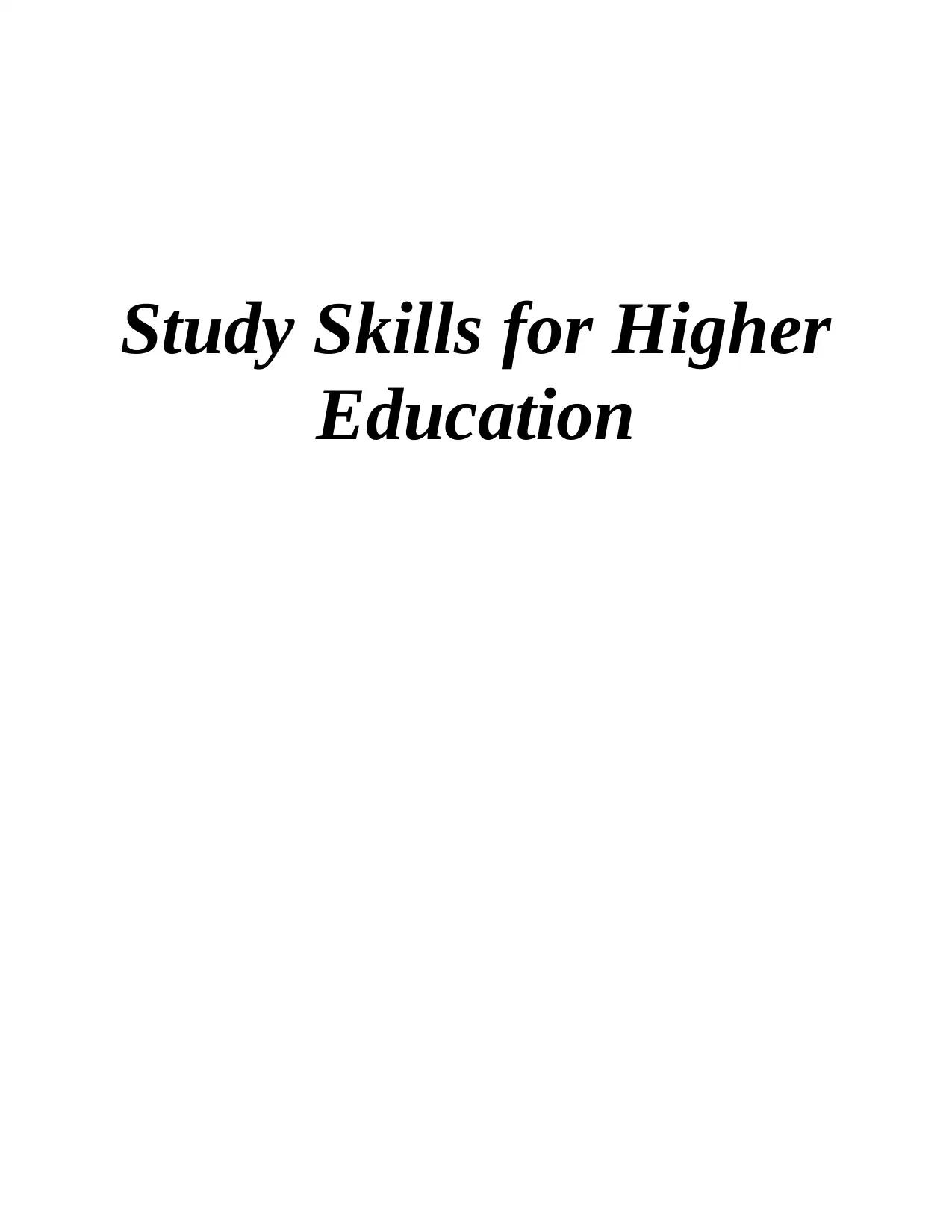
Study Skills for Higher
Education
Education
Paraphrase This Document
Need a fresh take? Get an instant paraphrase of this document with our AI Paraphraser
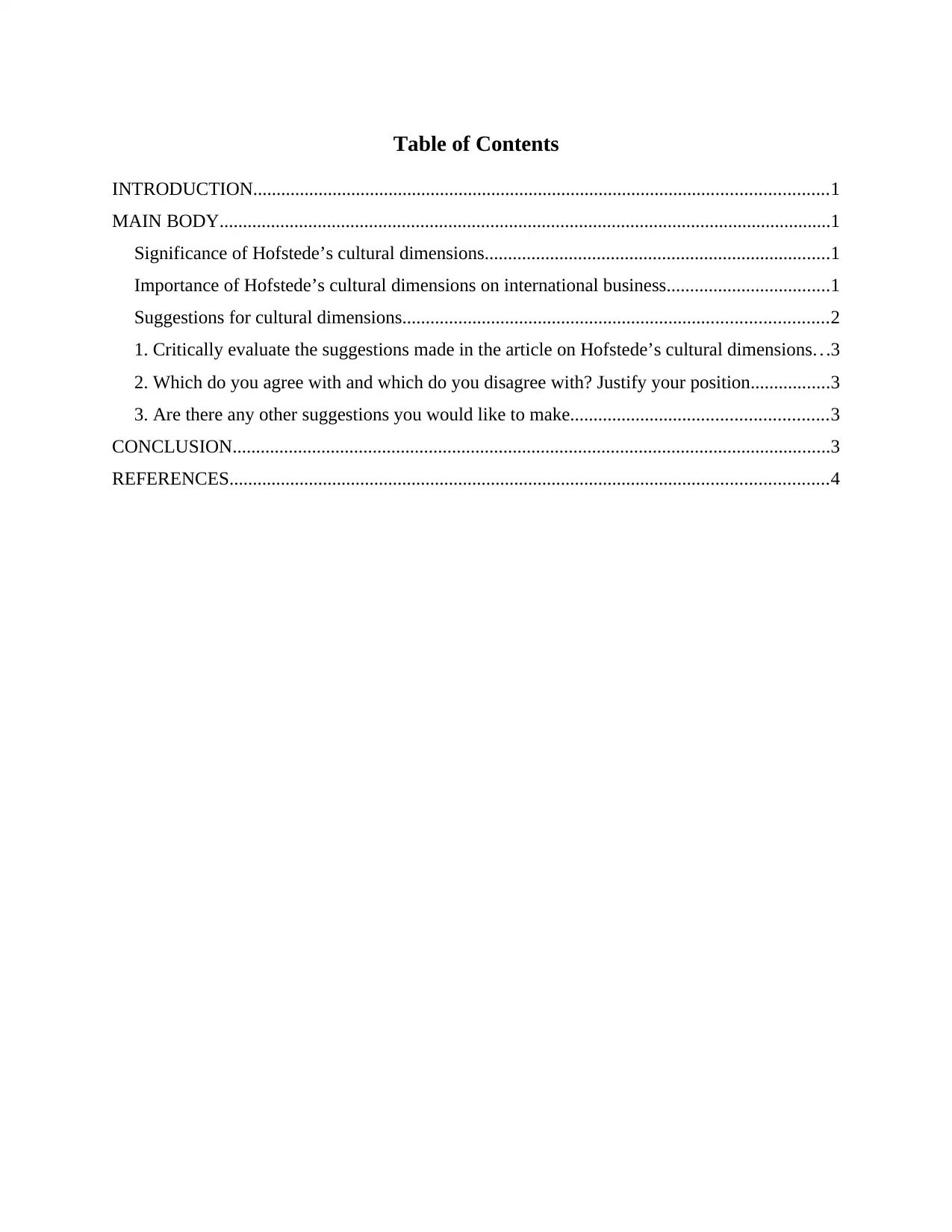
Table of Contents
INTRODUCTION...........................................................................................................................1
MAIN BODY...................................................................................................................................1
Significance of Hofstede’s cultural dimensions..........................................................................1
Importance of Hofstede’s cultural dimensions on international business...................................1
Suggestions for cultural dimensions...........................................................................................2
1. Critically evaluate the suggestions made in the article on Hofstede’s cultural dimensions. . .3
2. Which do you agree with and which do you disagree with? Justify your position.................3
3. Are there any other suggestions you would like to make.......................................................3
CONCLUSION................................................................................................................................3
REFERENCES................................................................................................................................4
INTRODUCTION...........................................................................................................................1
MAIN BODY...................................................................................................................................1
Significance of Hofstede’s cultural dimensions..........................................................................1
Importance of Hofstede’s cultural dimensions on international business...................................1
Suggestions for cultural dimensions...........................................................................................2
1. Critically evaluate the suggestions made in the article on Hofstede’s cultural dimensions. . .3
2. Which do you agree with and which do you disagree with? Justify your position.................3
3. Are there any other suggestions you would like to make.......................................................3
CONCLUSION................................................................................................................................3
REFERENCES................................................................................................................................4

⊘ This is a preview!⊘
Do you want full access?
Subscribe today to unlock all pages.

Trusted by 1+ million students worldwide
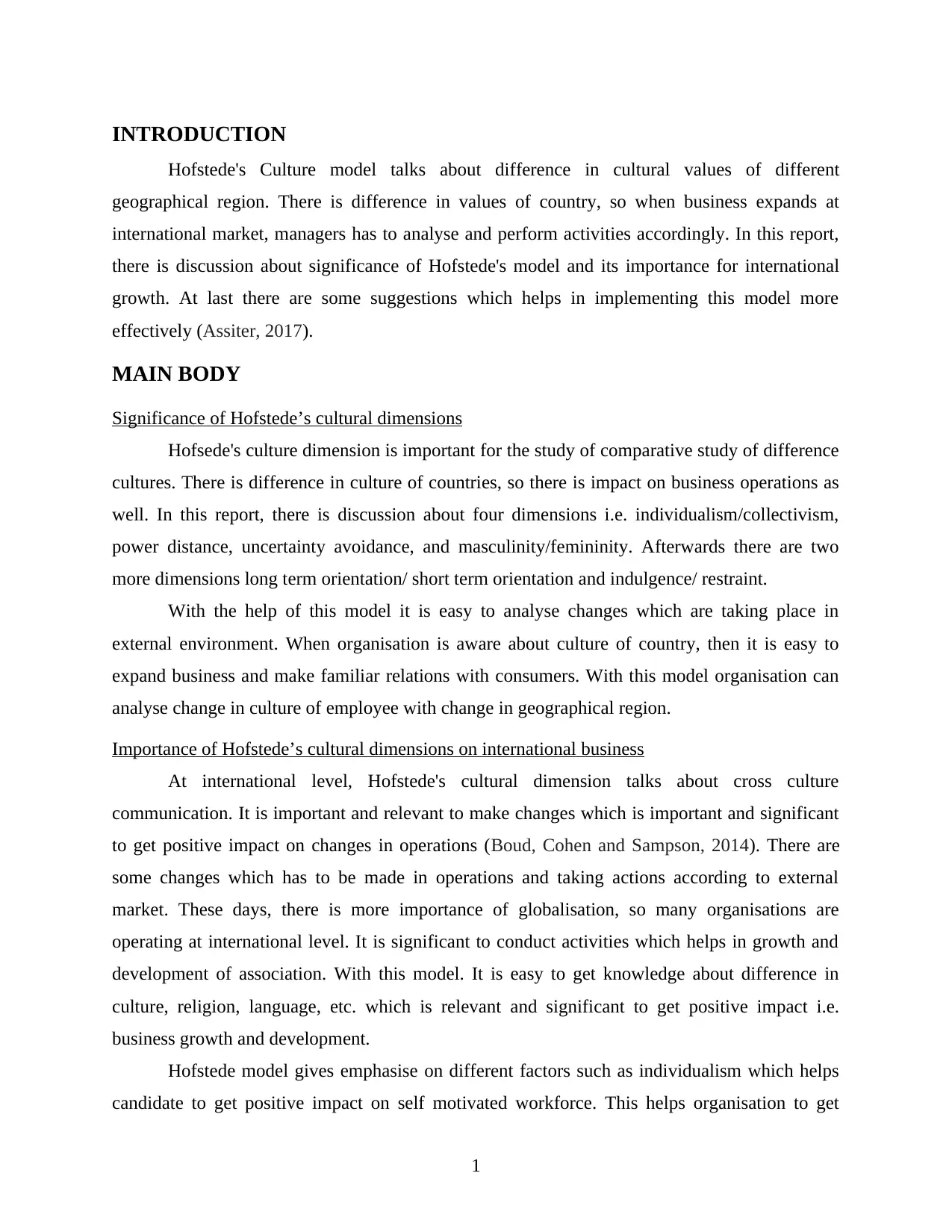
INTRODUCTION
Hofstede's Culture model talks about difference in cultural values of different
geographical region. There is difference in values of country, so when business expands at
international market, managers has to analyse and perform activities accordingly. In this report,
there is discussion about significance of Hofstede's model and its importance for international
growth. At last there are some suggestions which helps in implementing this model more
effectively (Assiter, 2017).
MAIN BODY
Significance of Hofstede’s cultural dimensions
Hofsede's culture dimension is important for the study of comparative study of difference
cultures. There is difference in culture of countries, so there is impact on business operations as
well. In this report, there is discussion about four dimensions i.e. individualism/collectivism,
power distance, uncertainty avoidance, and masculinity/femininity. Afterwards there are two
more dimensions long term orientation/ short term orientation and indulgence/ restraint.
With the help of this model it is easy to analyse changes which are taking place in
external environment. When organisation is aware about culture of country, then it is easy to
expand business and make familiar relations with consumers. With this model organisation can
analyse change in culture of employee with change in geographical region.
Importance of Hofstede’s cultural dimensions on international business
At international level, Hofstede's cultural dimension talks about cross culture
communication. It is important and relevant to make changes which is important and significant
to get positive impact on changes in operations (Boud, Cohen and Sampson, 2014). There are
some changes which has to be made in operations and taking actions according to external
market. These days, there is more importance of globalisation, so many organisations are
operating at international level. It is significant to conduct activities which helps in growth and
development of association. With this model. It is easy to get knowledge about difference in
culture, religion, language, etc. which is relevant and significant to get positive impact i.e.
business growth and development.
Hofstede model gives emphasise on different factors such as individualism which helps
candidate to get positive impact on self motivated workforce. This helps organisation to get
1
Hofstede's Culture model talks about difference in cultural values of different
geographical region. There is difference in values of country, so when business expands at
international market, managers has to analyse and perform activities accordingly. In this report,
there is discussion about significance of Hofstede's model and its importance for international
growth. At last there are some suggestions which helps in implementing this model more
effectively (Assiter, 2017).
MAIN BODY
Significance of Hofstede’s cultural dimensions
Hofsede's culture dimension is important for the study of comparative study of difference
cultures. There is difference in culture of countries, so there is impact on business operations as
well. In this report, there is discussion about four dimensions i.e. individualism/collectivism,
power distance, uncertainty avoidance, and masculinity/femininity. Afterwards there are two
more dimensions long term orientation/ short term orientation and indulgence/ restraint.
With the help of this model it is easy to analyse changes which are taking place in
external environment. When organisation is aware about culture of country, then it is easy to
expand business and make familiar relations with consumers. With this model organisation can
analyse change in culture of employee with change in geographical region.
Importance of Hofstede’s cultural dimensions on international business
At international level, Hofstede's cultural dimension talks about cross culture
communication. It is important and relevant to make changes which is important and significant
to get positive impact on changes in operations (Boud, Cohen and Sampson, 2014). There are
some changes which has to be made in operations and taking actions according to external
market. These days, there is more importance of globalisation, so many organisations are
operating at international level. It is significant to conduct activities which helps in growth and
development of association. With this model. It is easy to get knowledge about difference in
culture, religion, language, etc. which is relevant and significant to get positive impact i.e.
business growth and development.
Hofstede model gives emphasise on different factors such as individualism which helps
candidate to get positive impact on self motivated workforce. This helps organisation to get
1
Paraphrase This Document
Need a fresh take? Get an instant paraphrase of this document with our AI Paraphraser
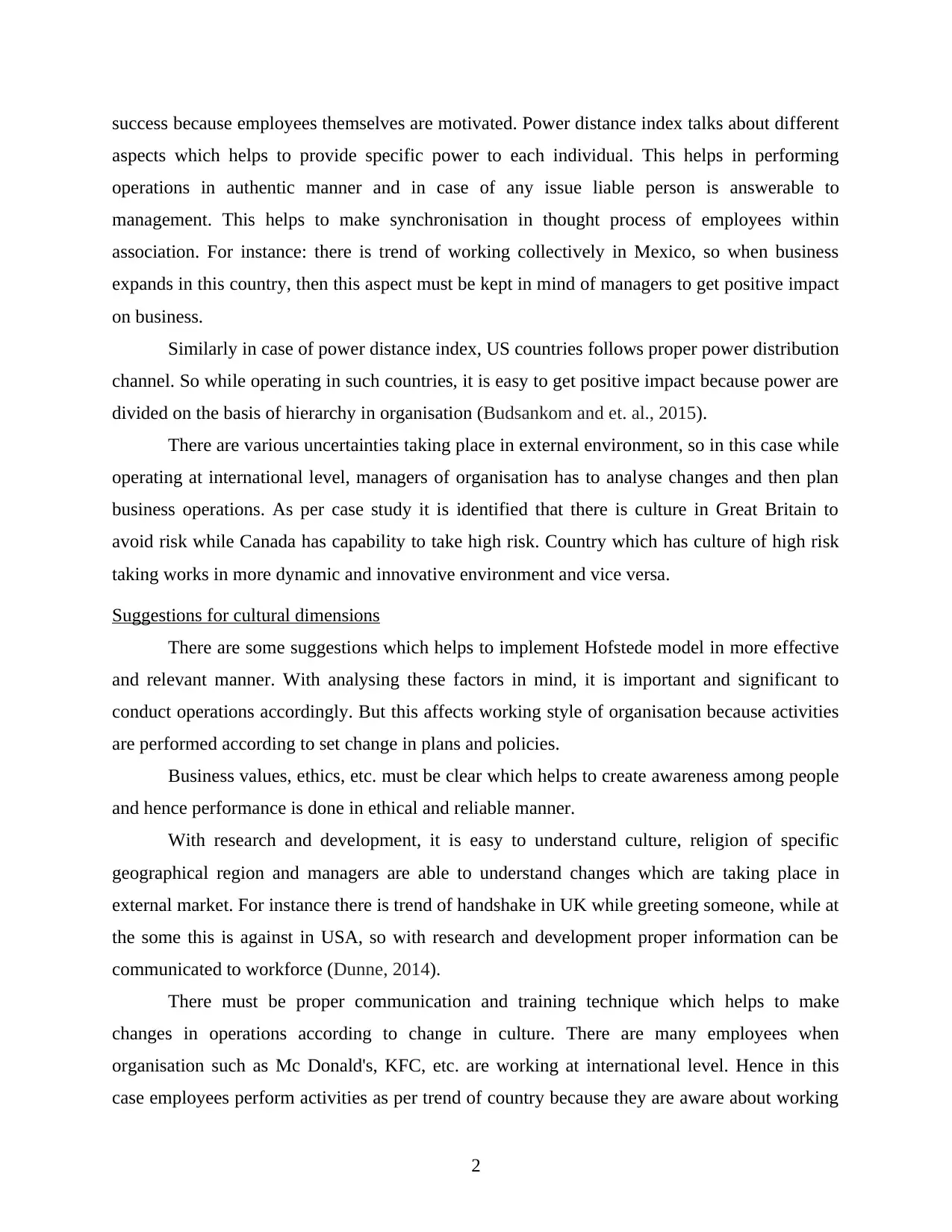
success because employees themselves are motivated. Power distance index talks about different
aspects which helps to provide specific power to each individual. This helps in performing
operations in authentic manner and in case of any issue liable person is answerable to
management. This helps to make synchronisation in thought process of employees within
association. For instance: there is trend of working collectively in Mexico, so when business
expands in this country, then this aspect must be kept in mind of managers to get positive impact
on business.
Similarly in case of power distance index, US countries follows proper power distribution
channel. So while operating in such countries, it is easy to get positive impact because power are
divided on the basis of hierarchy in organisation (Budsankom and et. al., 2015).
There are various uncertainties taking place in external environment, so in this case while
operating at international level, managers of organisation has to analyse changes and then plan
business operations. As per case study it is identified that there is culture in Great Britain to
avoid risk while Canada has capability to take high risk. Country which has culture of high risk
taking works in more dynamic and innovative environment and vice versa.
Suggestions for cultural dimensions
There are some suggestions which helps to implement Hofstede model in more effective
and relevant manner. With analysing these factors in mind, it is important and significant to
conduct operations accordingly. But this affects working style of organisation because activities
are performed according to set change in plans and policies.
Business values, ethics, etc. must be clear which helps to create awareness among people
and hence performance is done in ethical and reliable manner.
With research and development, it is easy to understand culture, religion of specific
geographical region and managers are able to understand changes which are taking place in
external market. For instance there is trend of handshake in UK while greeting someone, while at
the some this is against in USA, so with research and development proper information can be
communicated to workforce (Dunne, 2014).
There must be proper communication and training technique which helps to make
changes in operations according to change in culture. There are many employees when
organisation such as Mc Donald's, KFC, etc. are working at international level. Hence in this
case employees perform activities as per trend of country because they are aware about working
2
aspects which helps to provide specific power to each individual. This helps in performing
operations in authentic manner and in case of any issue liable person is answerable to
management. This helps to make synchronisation in thought process of employees within
association. For instance: there is trend of working collectively in Mexico, so when business
expands in this country, then this aspect must be kept in mind of managers to get positive impact
on business.
Similarly in case of power distance index, US countries follows proper power distribution
channel. So while operating in such countries, it is easy to get positive impact because power are
divided on the basis of hierarchy in organisation (Budsankom and et. al., 2015).
There are various uncertainties taking place in external environment, so in this case while
operating at international level, managers of organisation has to analyse changes and then plan
business operations. As per case study it is identified that there is culture in Great Britain to
avoid risk while Canada has capability to take high risk. Country which has culture of high risk
taking works in more dynamic and innovative environment and vice versa.
Suggestions for cultural dimensions
There are some suggestions which helps to implement Hofstede model in more effective
and relevant manner. With analysing these factors in mind, it is important and significant to
conduct operations accordingly. But this affects working style of organisation because activities
are performed according to set change in plans and policies.
Business values, ethics, etc. must be clear which helps to create awareness among people
and hence performance is done in ethical and reliable manner.
With research and development, it is easy to understand culture, religion of specific
geographical region and managers are able to understand changes which are taking place in
external market. For instance there is trend of handshake in UK while greeting someone, while at
the some this is against in USA, so with research and development proper information can be
communicated to workforce (Dunne, 2014).
There must be proper communication and training technique which helps to make
changes in operations according to change in culture. There are many employees when
organisation such as Mc Donald's, KFC, etc. are working at international level. Hence in this
case employees perform activities as per trend of country because they are aware about working
2

style. This helps to create understanding among workers related to performing activities in
international market.
1. Critically evaluate the suggestions made in the article on Hofstede’s cultural dimensions
There are two suggestion which made under Hofstede model which helps to get positive
impact on performance of overall organisation. There are positive as well as negative aspects of
these suggestion which is discussed as under-
In case when all the factors of business environment of some specific country is analysed,
then this helps to get positive impact on operations (Assiter, 2017). This is crucial and
relevant for getting positive outcome. While this process can be time consuming and
there are possibilities that core operations of organisations may get affected in negative
manner.
With research and development, business operations of organisation is performed in best
manner. While negative impact with research and development is that it is more time and
cost consuming.
2. Which do you agree with and which do you disagree with? Justify your position
As per case study there is discussion about making values, ethics and code of conduct in
more viable and clear form. With this suggestion individual is agree because this helps to get
success in industry. Performance of individual is in ethical and reliable manner. This helps to
reduce possibilities of government interference and betrayal in industry.
While use of proper research and development is not relevant because while working at
new place employees and management of organisation get to know about it. Hence with research
it sounds to be time and cost consuming process (Earley, 2014).
3. Are there any other suggestions you would like to make
At last there are some other recommendations such as flexible working style of
organisation. This is significant for accepting change in culture of various countries and
performing business activities according to external market.
CONCLUSION
From the above discussion, cross culture Hofstede model of dimension is clear. There are
some suggestions such as analysis of factor such as proper communication technique, research
3
international market.
1. Critically evaluate the suggestions made in the article on Hofstede’s cultural dimensions
There are two suggestion which made under Hofstede model which helps to get positive
impact on performance of overall organisation. There are positive as well as negative aspects of
these suggestion which is discussed as under-
In case when all the factors of business environment of some specific country is analysed,
then this helps to get positive impact on operations (Assiter, 2017). This is crucial and
relevant for getting positive outcome. While this process can be time consuming and
there are possibilities that core operations of organisations may get affected in negative
manner.
With research and development, business operations of organisation is performed in best
manner. While negative impact with research and development is that it is more time and
cost consuming.
2. Which do you agree with and which do you disagree with? Justify your position
As per case study there is discussion about making values, ethics and code of conduct in
more viable and clear form. With this suggestion individual is agree because this helps to get
success in industry. Performance of individual is in ethical and reliable manner. This helps to
reduce possibilities of government interference and betrayal in industry.
While use of proper research and development is not relevant because while working at
new place employees and management of organisation get to know about it. Hence with research
it sounds to be time and cost consuming process (Earley, 2014).
3. Are there any other suggestions you would like to make
At last there are some other recommendations such as flexible working style of
organisation. This is significant for accepting change in culture of various countries and
performing business activities according to external market.
CONCLUSION
From the above discussion, cross culture Hofstede model of dimension is clear. There are
some suggestions such as analysis of factor such as proper communication technique, research
3
⊘ This is a preview!⊘
Do you want full access?
Subscribe today to unlock all pages.

Trusted by 1+ million students worldwide

and development, etc. which helps to get positive impact on expansion of business. Apart from
this there was suggestion regarding working with flexible plans ad policies.
4
this there was suggestion regarding working with flexible plans ad policies.
4
Paraphrase This Document
Need a fresh take? Get an instant paraphrase of this document with our AI Paraphraser
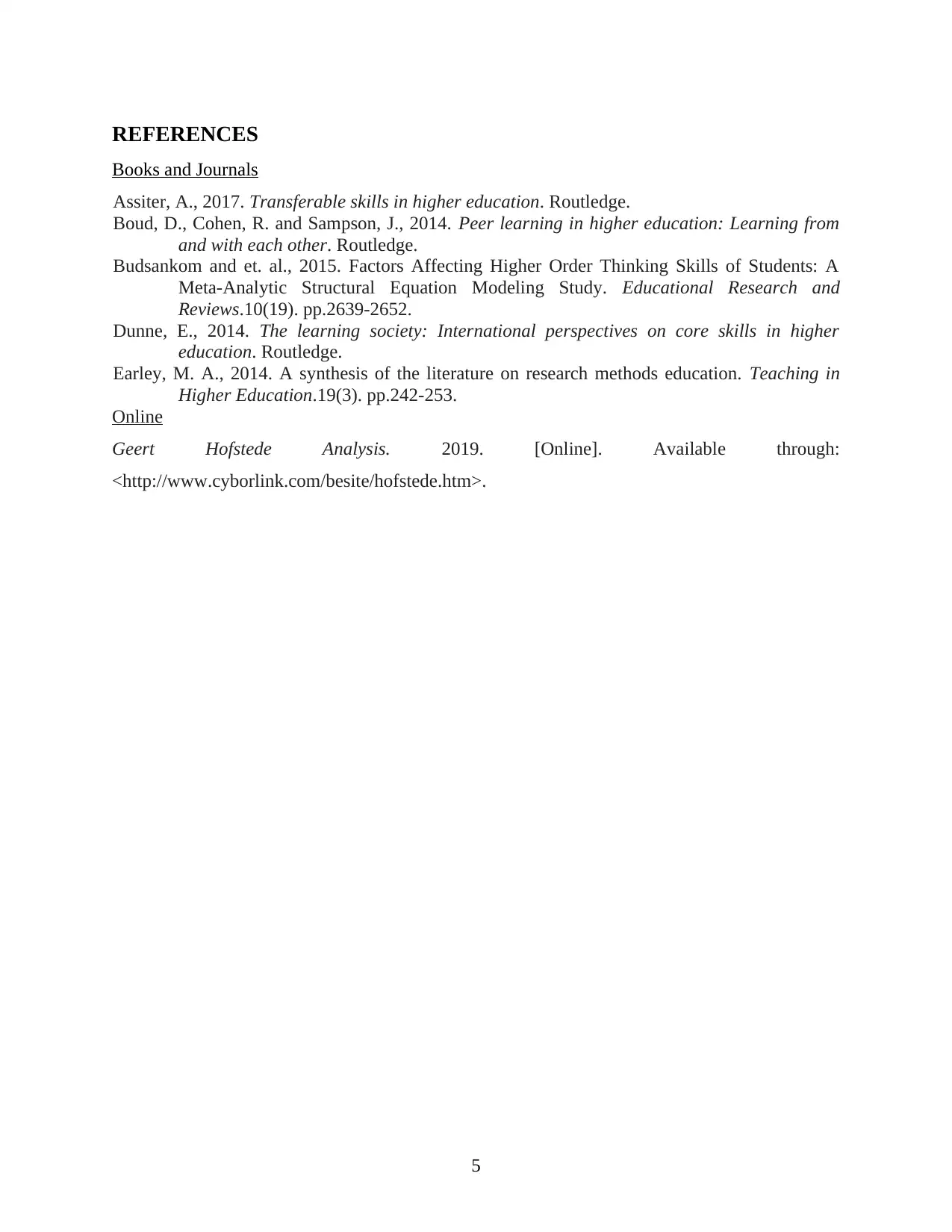
REFERENCES
Books and Journals
Assiter, A., 2017. Transferable skills in higher education. Routledge.
Boud, D., Cohen, R. and Sampson, J., 2014. Peer learning in higher education: Learning from
and with each other. Routledge.
Budsankom and et. al., 2015. Factors Affecting Higher Order Thinking Skills of Students: A
Meta-Analytic Structural Equation Modeling Study. Educational Research and
Reviews.10(19). pp.2639-2652.
Dunne, E., 2014. The learning society: International perspectives on core skills in higher
education. Routledge.
Earley, M. A., 2014. A synthesis of the literature on research methods education. Teaching in
Higher Education.19(3). pp.242-253.
Online
Geert Hofstede Analysis. 2019. [Online]. Available through:
<http://www.cyborlink.com/besite/hofstede.htm>.
5
Books and Journals
Assiter, A., 2017. Transferable skills in higher education. Routledge.
Boud, D., Cohen, R. and Sampson, J., 2014. Peer learning in higher education: Learning from
and with each other. Routledge.
Budsankom and et. al., 2015. Factors Affecting Higher Order Thinking Skills of Students: A
Meta-Analytic Structural Equation Modeling Study. Educational Research and
Reviews.10(19). pp.2639-2652.
Dunne, E., 2014. The learning society: International perspectives on core skills in higher
education. Routledge.
Earley, M. A., 2014. A synthesis of the literature on research methods education. Teaching in
Higher Education.19(3). pp.242-253.
Online
Geert Hofstede Analysis. 2019. [Online]. Available through:
<http://www.cyborlink.com/besite/hofstede.htm>.
5
1 out of 8
Related Documents
Your All-in-One AI-Powered Toolkit for Academic Success.
+13062052269
info@desklib.com
Available 24*7 on WhatsApp / Email
![[object Object]](/_next/static/media/star-bottom.7253800d.svg)
Unlock your academic potential
Copyright © 2020–2025 A2Z Services. All Rights Reserved. Developed and managed by ZUCOL.




